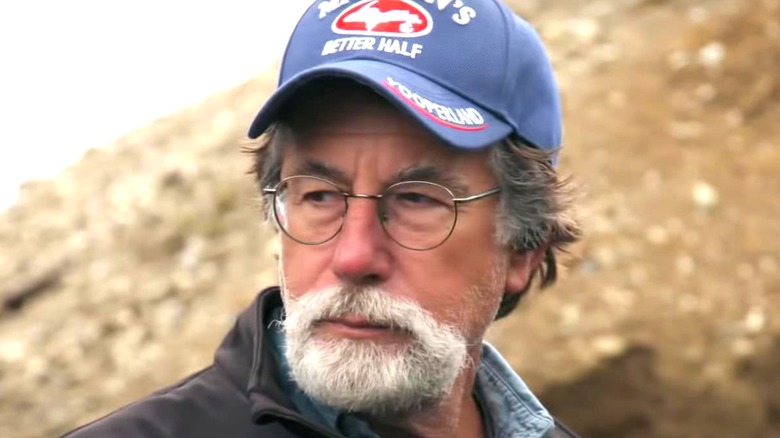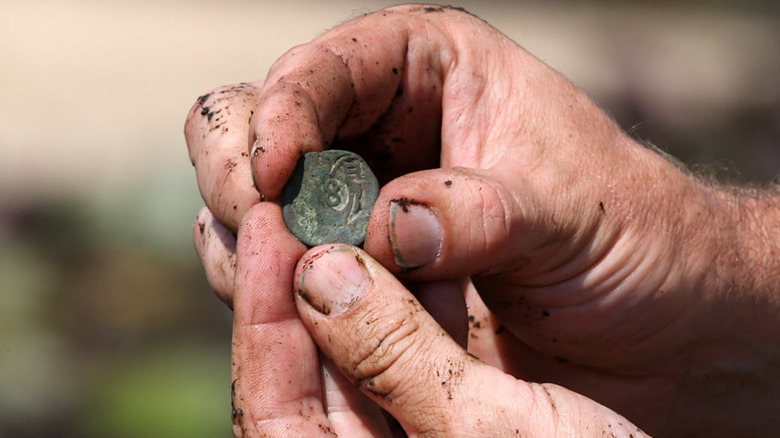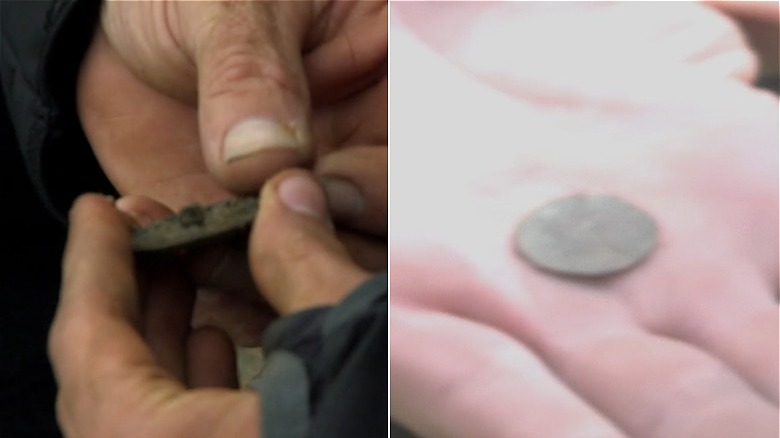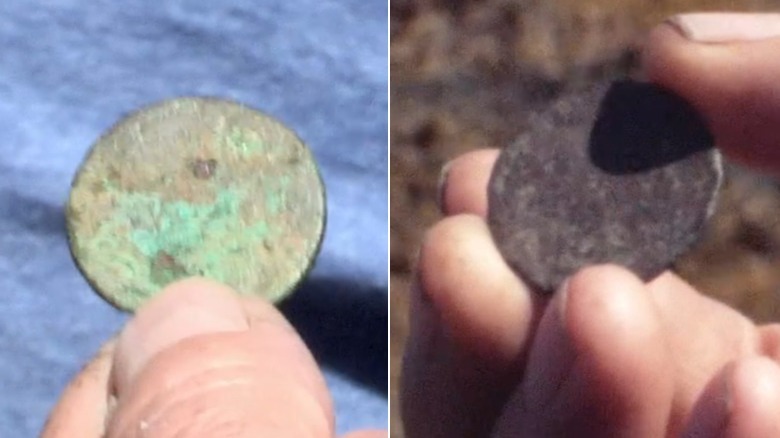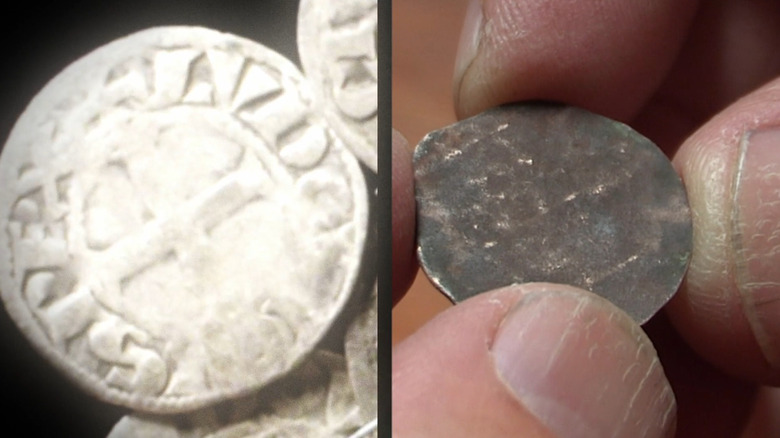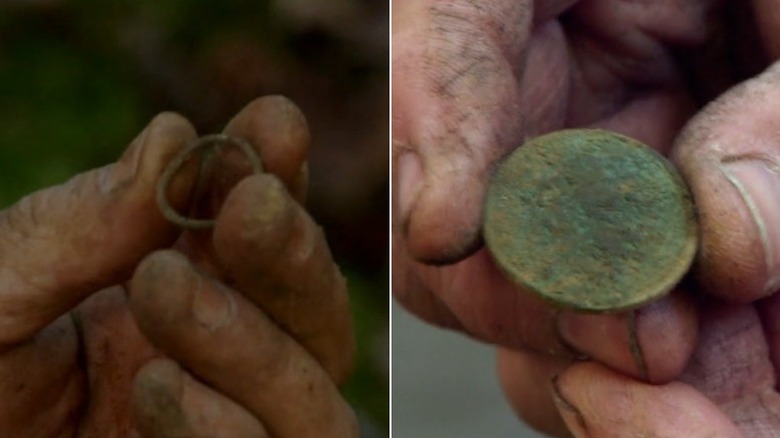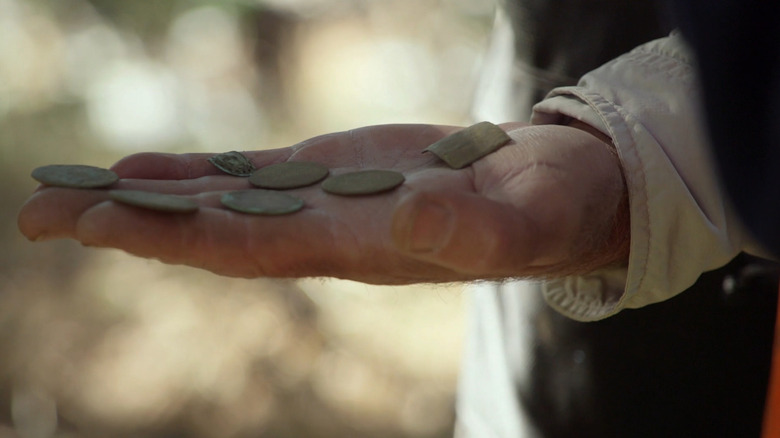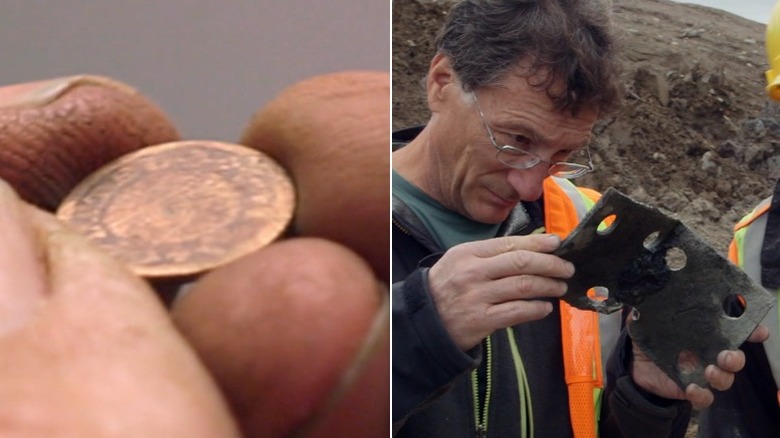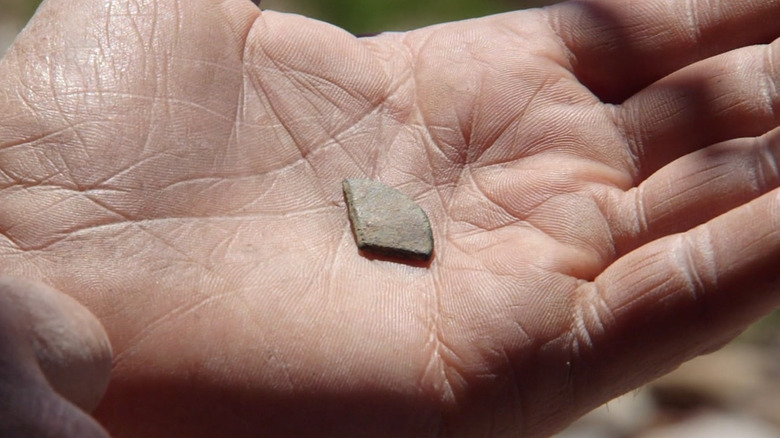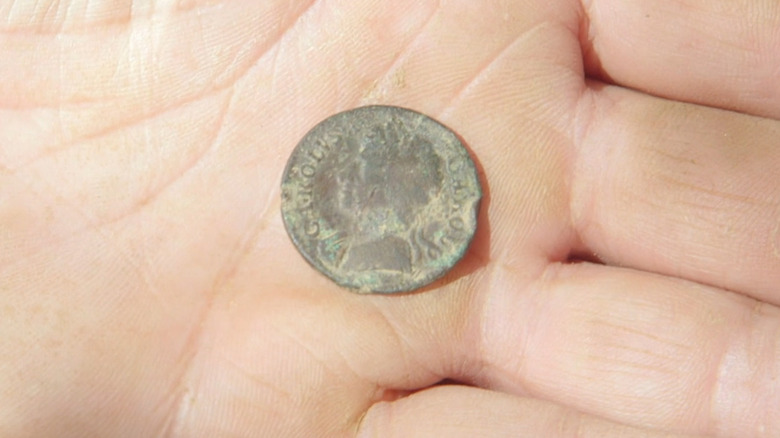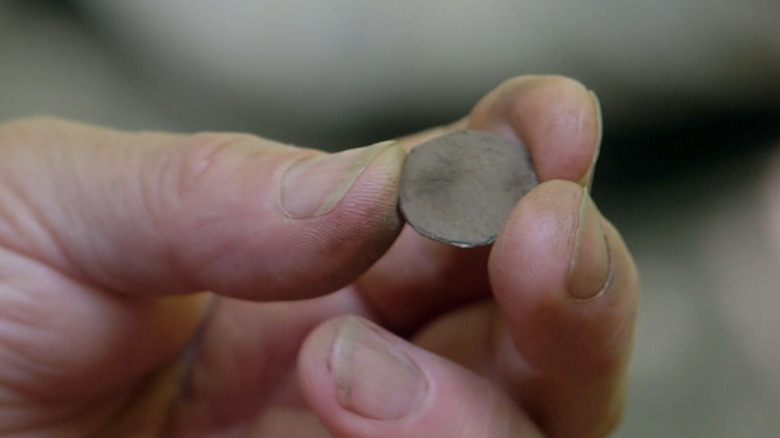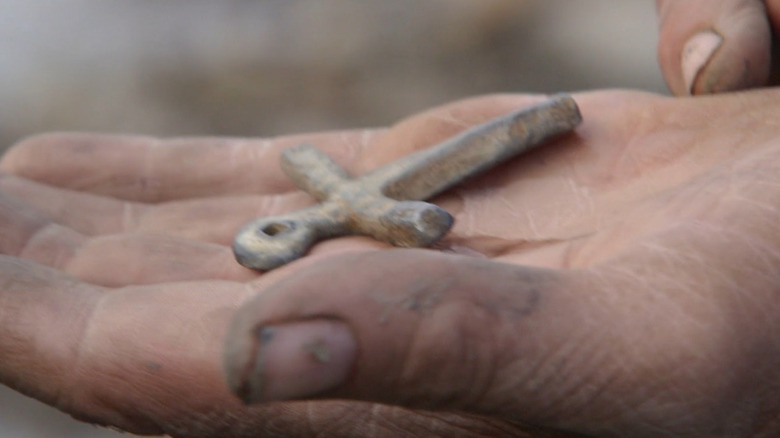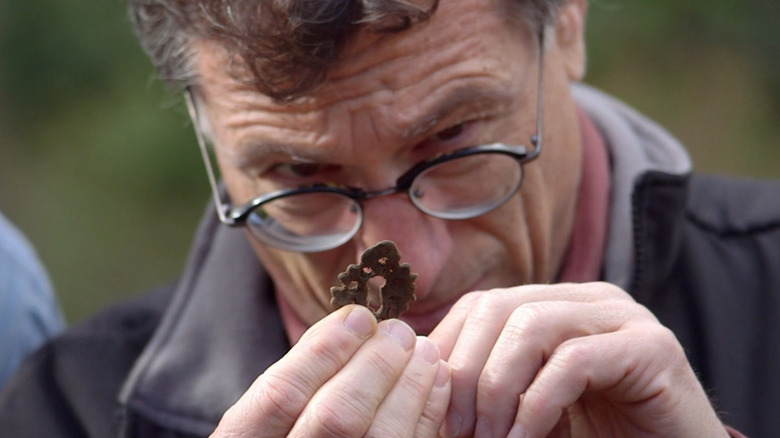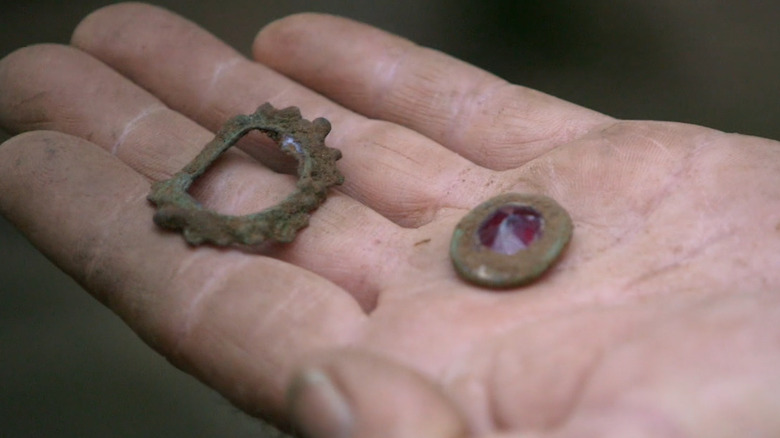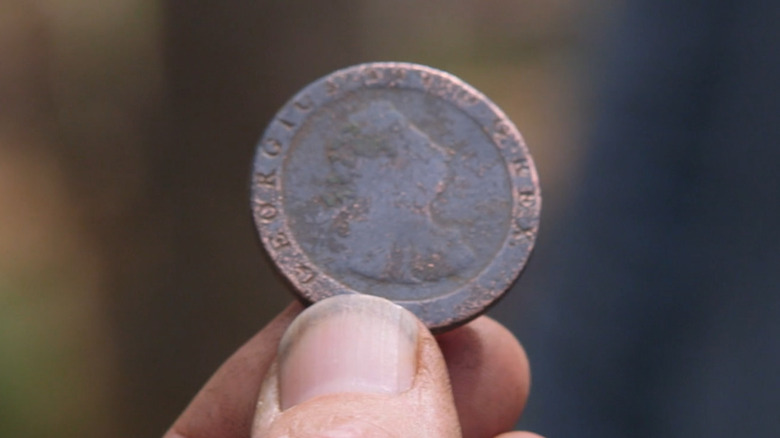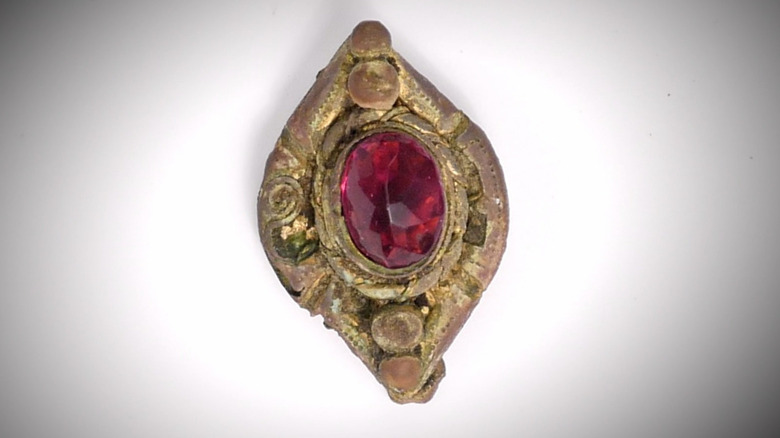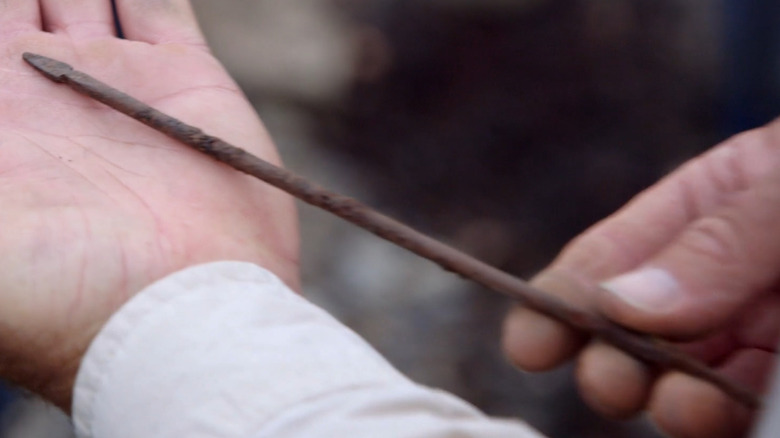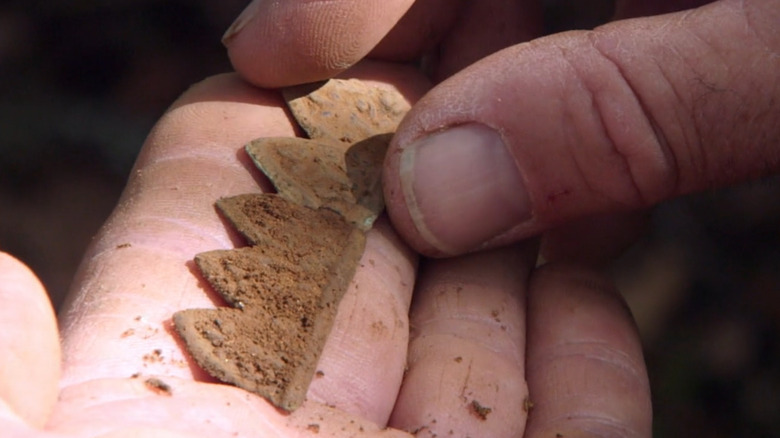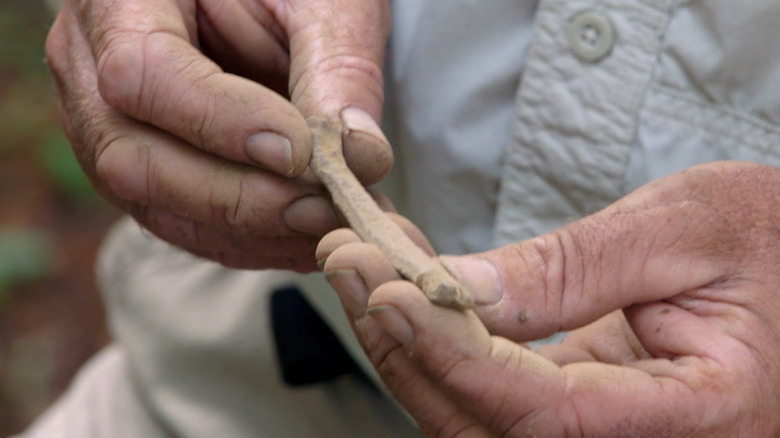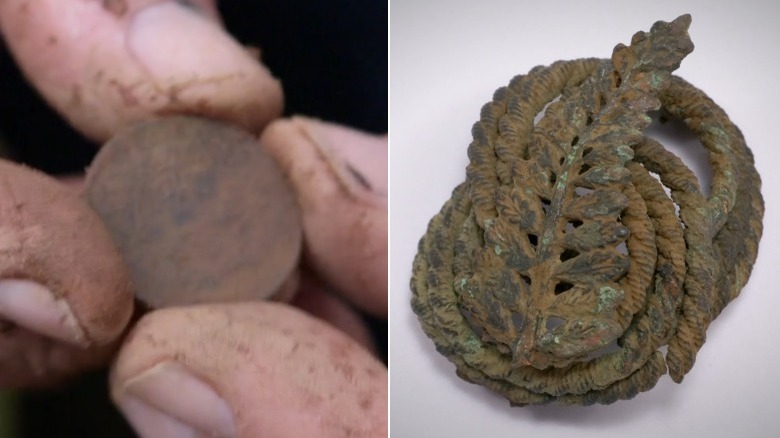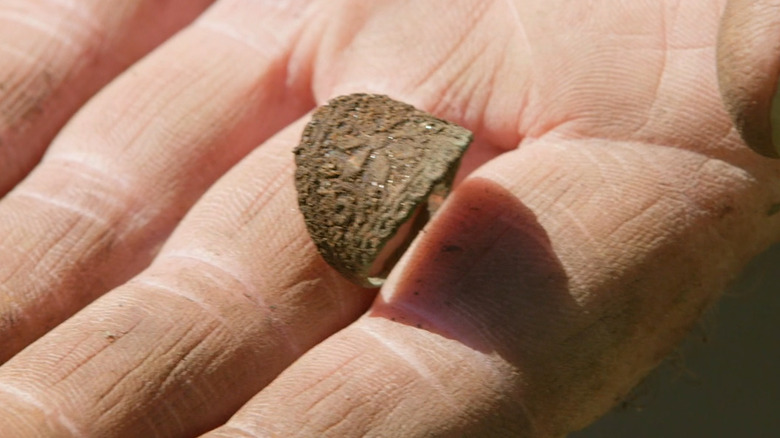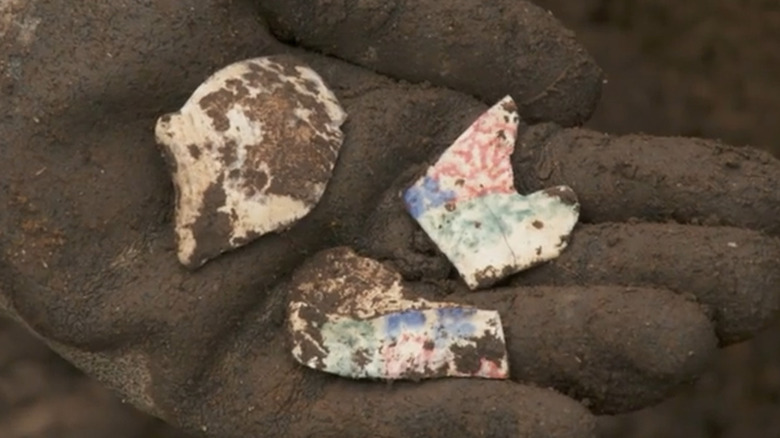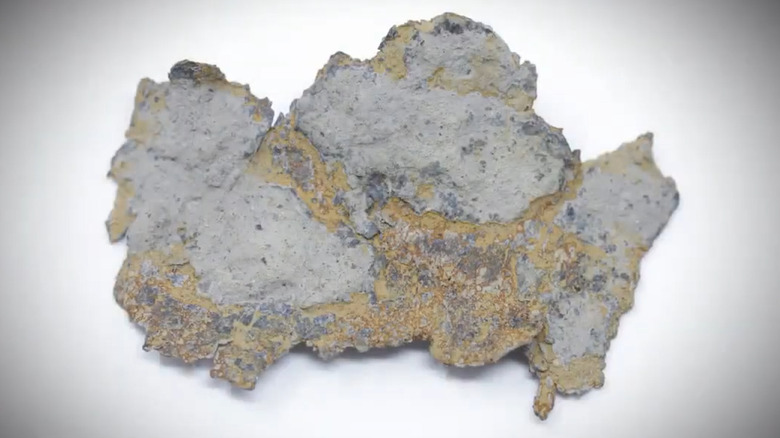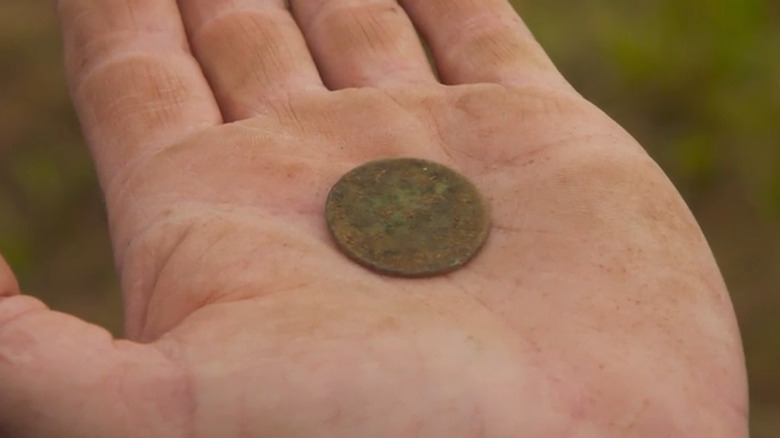All The Treasure Ever Found On The Curse Of Oak Island
Brothers Marty and Rick Lagina and their team of treasure hunters have been digging around a Nova Scotian island for over eight years on the popular History Channel show "The Curse of Oak Island." During this nine season run, the Lagina Brothers have been on a constant search for hidden treasure, perhaps buried on the island by Spanish pirates, the British military, or even the Knights Templar.
While the Lagina brothers and metal detection expert Gary Drayton have mostly found mud, wood, and various metal tools, they — along with an assortment of science and archaeological experts — have made a surprising amount of valuable discoveries hidden throughout the 140 acres of the supposedly cursed Oak Island.
But what exactly are these interesting finds, and what historical secrets could they reveal? Perhaps the truth lies within, as we uncover all the treasure ever found on "The Curse of Oak Island."
Maravedí copper coin
In "The Curse of Oak Island" Season 1 finale "The Find," while searching through a swamp, metal detection expert Steve Zazulyk ran across a coin with the number "8" engraved on it. It was later identified as a Spanish eight Maravedis copper coin, most likely from the 17th century.
In the Season 2 premiere "Once In, Forever In," the coin was cleaned and examined, revealing that the year 1652 was engraved on the back. Further analysis of the coin also revealed that it had, in fact been lost, in the swamp for hundreds of years, and not something planted recently. All the signs pointed to this being a legitimate historical discovery, the first of many throughout the show.
Could this simple copper coin be evidence of hidden pirate wealth? It certainly seemed like the Lagina brothers were on the right track to uncover the legendary buried treasure of Oak Island.
17th century military button and a coin
In "Return to the Money Pit," the second episode of the second season of "The Curse of Oak Island," treasure hunter Gary Drayton discovered not two distinct treasures while metal detecting.
His first discovery was made near Oak Island's shoreline. Drayton and his team found a 17th century button from a military officer's outfit, though which military it might belong to is unknown. However, it could be evidence that this military was responsible for some of the buried secrets around the island.
In a nearby wooded location, Drayton and his team made their second discovery of the day. Buried in the ground was a small coin, what they assumed to be another 17th century Maravedi like the one found in the previous season's finale. However, this coin appeared to be of a much smaller size; perhaps two Maravedis rather than eight. Though smaller, these incredible finds could still lead to a much larger treasure hidden somewhere on Oak Island.
Two 17th century Britannia coins
In "The Eight-Pointed Star," the third episode of the second season of "The Curse of Oak Island," treasure hunter Gary Drayton made another double discovery while metal detecting along the shoreline of Oak Island.
This time around, Drayton and his team along with the Oak Island team leader Rick Lagina found two 17th century King Charles II Britannia coins, buried beneath the rocks and pyrite scattered across the shore. One of the coins found had the year 1771 clearly printed on its surface, seemingly confirming the centuries old age of the currency.
Where did these 17th century coins come from? Could they have been dropped by hurried individuals on their way to find buried treasure? Or, perhaps more hopefully, could they have been dropped by a wealthy group out on Oak Island to bury treasure of their own? Certainly, the Oak Island team would have to investigate further.
The Knights Templar coin
In "The 90-Foot Stone," the fifth episode of the second season of "The Curse of Oak Island," the small coin that Gary Drayton and his team had discovered three episodes earlier in "Return to the Money Pit" was inspected. It turned out to not be a Maravedi coin at all, but instead something far more interesting.
After cleaning the coin, treasure hunter and professional diver Tony Sampson saw what appeared to be a cross design on one side. This distinctive cross could be the symbol of the Knights Templar who, in the 13th century, had instituted one of the first international banking systems. Could this be a coin used by the Knights Templar for banking purposes?
What at first appeared to be the discovery of a small Spanish Maravedi coin, could instead be a significant lead towards a vast Knights Templar fortune buried somewhere on Oak Island.
A copper ring and a coin
In "Circles in Wood," the sixth episode of the fourth season of "The Curse of Oak Island," Gary Drayton — along with associate producers and fellow treasure hunters Jack Begley and Alex Lagina — do some metal detecting on property once owned by former slave-turned-cabbage farmer Samuel Ball.
After initially finding a length of chain buried in the ground, Drayton and company expanded their search outward, eventually finding a small copper and bronze ring. Certain that they were on the right path, they continued their efforts and uncovered a coin that could be hundreds of years old.
Samuel Ball owned 36 acres of Oak Island and was said to be one of its wealthiest residents. Did the source of this wealth come from cabbage farming? Or had Ball discovered treasure? Maybe these findings are just a small piece of the treasure Ball found on Oak Island.
18th century coins and a name tag
In Season 4, Episode 8 — "The Mystery of Samuel Ball" — metal detection expert Gary Drayton and Oak Island historian Charles Barkhouse continue to dig around on Samuel Ball's property and unearth a multitude of interesting finds.
Drayton and Barkhouse initially find a dandy button, generally found on clothing from the 1700s. They soon find a lead ingot used for making musket balls, as well as several King George II coins also from the 1700s. After uncovering what might be a metal tag from the bottom of a pistol with a name etched on it (that some online researchers believe might have been Samuel Ball's own), Drayton theorizes that all of these artifacts could be the remnants of a military encampment.
Were these 18th century campers on the search for buried treasure or leaving behind treasure of their own? The only thing known for certain is that there was definitely a lot of activity going on in the 1700s on Oak Island.
British military button and a treasure chest hinge
In "Blood is Thicker," Season 4, Episode 15 of "The Curse of Oak Island," Gary Drayton runs his metal detector over the unearthed contents of Rick and Marty Lagina's GAL-1 dig site. He is excited to discover the show's first appearance of buried gold.
While initially thinking it to be a coin, they quickly realize it has the word "plated" engraved on it. After having it examined by antiques appraiser Dr. Lori Vanderame, it seems most likely that this circular object was actually a gold-plated button from a 17th or 18th century British military uniform.
This seems even more likely when the Lagina Brothers retrieve a large metal hinge with drill holes in it from the same location. After examining it, Dr. Vanderame says it came from the same time period. What's more exciting is that it was frequently used for the hinges of treasure chests. While it may instead have come from a ship repurposing the hinge for another use, it is still an incredibly exciting find for the questions it raises about what lies beneath Oak Island.
A cut maravedi coin
In "Dead Man's Chest," the second episode of the fifth season of "The Curse of Oak Island," Gary Drayton and his metal detection team once again uncover clues to 17th century involvement on the island — possibly from the military, pirates, or both.
After initially digging up a musket ball used in 17th century guns, they soon find what appears to be a maravedi, similar to what was found in the Season 1 finale "The Find." The difference here is that this coin has been cut into a smaller segment.
Back in the 17th century, coins like the maravedi used to be cut to provide change, leading to the phrase "Pieces of eight" popularized by the Robert Louis Stevenson pirate novel classic "Treasure Island." Yet another puzzle piece in favor of pirates frequenting the shores of Oak Island. Could their be more piratical discoveries to be made?
17th century English coins
The Lagina Brothers and Gary Drayton continue their search for buried treasure by exploring the Dunfield Spoils in "The Curse of Oak Island" Season 5, Episode 3 "Obstruction."
In 1965, Robert Dunfield attempted to find the legendary Oak Island treasure and dug a 100 foot wide by 140 foot deep hole in order to find it. However, no treasure was ever found and eventually the large hole caved in on itself. But the excavated earth was left behind and became known as the Dunfield Spoils.
Armed with a metal detector, the Oak Island team explored these leftover spoils and soon found a pair of English coins with King Charles II's face on one side and the years "1673" and "1694" inscribed on the other. The discovery of these pair of coins indicate that either the English military or pirates were on Oak Island in the 1700s.
17th century coin
In "Dan's Breakthrough," Season 5, Episode 8 of "The Curse of Oak Island," the Lagina Brothers and Gary Drayton return to Lot 16 near where they had previously found the two English coins in the earlier Season 5 episode "Obstruction," and continue their search for hidden treasures.
The treasure hunting trio soon make a trio of discoveries. First they find a part of a small horseshoe, perhaps made for a mule or a pony. That is quickly followed up by a more incredible find: A piece of ammunition called grapeshot. Grapeshot were small round balls usually composed of iron that were fired from ship cannons. Their third and final discovery was of another small coin, presumably from the 17th century like many of the coins previously found on the island.
With these consistent findings of 17th century artifacts, the pieces add up to fill in the mysterious puzzle of Oak Island.
A small lead cross
Gary Drayton and Rick Lagina go metal detecting along the shoreline and find what appears to be a religious artifact in Season 5, Episode 10 "The Signs of a Cross."
Drayton dates the solid lead cross to somewhere between the 1200s and the 1600s. Lagina connects it to the Knights Templar, as the design is reminiscent of a carving he saw at a Templar prison he visited in Domme, France in Season 5, Episode 8 "Dan's Breakthrough."
Later, in Season 5, Episode 12 "A Key to the Mystery," Templar expert Jerry Glover examines the cross and estimates that it might be from the 13th century. He further connects it to Templar graffiti from a similar timeframe. This connection to the Knights Templar becomes even more concrete after further investigations into the cross occur in Season 5, Episode 13 "Unhinged" and Season 5, Episode 15 "Steel Trapped."
A decorative keyhole plate
In the 15th episode of the fifth season, "Steel Trapped," Gary Drayton and the Lagina Brothers take their metal detecting skills to the property of former treasure hunter Fred Nolan, now maintained by his son Tom Nolan.
Drayton soon digs up what appears to be a handmade decorative keyhole plate. Drayton claims the artifact is unlikely to be used by farmers or everyday people, so it seems very possible that this keyplate could be a piece of a treasure chest. This would be a quite an exciting find, if true.
Adding this floral-designed keyplate to previous discoveries — like the skeleton key Tom Nolan showed the team earlier in Season 5, Episode 12 "A Key to the Mystery" and the treasure chest hinge found Season 4, Episode 15 "Blood is Thicker" — indicates that the likelihood of the Oak Island team finally finding a buried treasure trove seems to be increasing.
Garnet brooch
In Season 5, Episode 16 "Seeing Red," Rick Lagina and Gary Drayton return to the site where they had found the decorative keyhole in the previous episode. Lagina and Drayton soon discover an item of far greater value.
After first finding a 17th century military button like the one found in Season 2, Episode 2 "Return to the Money Pit," the stakes are significantly raised when they uncover a brooch and what at first appears to be a multifaceted ruby. In the Season 5 finale "Amazing Discoveries," Drayton has the jewelry examined by a gemologist and discovers that it's actually a hand-cut rhodolite garnet set in silver, dated to be from around the 1500 or 1600s.
While many discoveries had been made prior, this semi-precious gemstone would be the most valuable treasure the Lagina team had found up to that point. What further treasures awaited them on Oak Island?
Copper cartwheel twopence coin
In "Rick's Big Bang Theory," the Season 6 premiere of "The Curse of Oak Island," Gary Drayton and Rick Lagina take the metal detector to a previously unexplored area of Oak Island to see what hidden treasures Oak Island has to offer them.
Pulling up a large boulder, Drayton and Lagina find underneath a large copper twopence coin featuring the face of King George III. This specific style of coin was only minted in 1797 and was made of copper instead of the usual silver. This caused the coin to be much larger than its twopence counterparts, which led to the coins being commonly known as a cartwheel.
With the discovery of this cartwheel, as well as the large amount of other 17th and 18th century coins the Oak Island team has dug up, it seems like finding a hoard of buried treasure seems like could be just on the horizon.
Gold plated brooch
Towards the end of the Season 6 premiere "Rick's Big Bang Theory," Gary Drayton and Rick Lagina search for treasure near the home of Daniel McGinnis, one of the original Oak Island treasure hunters from the 1700s.
Putting his metal detector to good use, Drayton locks onto a signal. Lagina proceeds to dig up a jeweled brooch, their second such find after the garnet brooch found in last season's "Seeing Red."
In the following Season 6 episode, "Gold Rush," the brooch is taken to gemologist Charles Lewton-Brain who says that the gem is actually leaded glass, though a threaded technique used on the brooch dates the jewelry to the 14th century or earlier. Further analysis on the brooch by Dr. Christa Brosseau and her colleague Dr. Xiang Yang using an electron microscope proves that part of the brooch is made of gold. While the gem itself was deceptively disappointing, the brooch wrapped around it proved to be a true treasure of Oak Island.
A Roman pilum
Gary Drayton and Jack Begley are joined by geophysicist Mike West, who uses a metal detection device that penetrates deeper than Drayton's usual handheld metal detector, in "Depth Perception," the third episode of the sixth season of "The Curse of Oak Island."
After finding a 17th century spike and a metal hook, they dig up their biggest find: A long bolt with an arrow-shaped tip. Drayton believes it to be a 17th century crossbow bolt.
In the following episode "A Legacy Revealed," antiquities expert Gabriel Vandervort takes a look at the item and discovers that it might not be a crossbow bolt at all, but rather the top part of a pilum, a type of javelin weapon used by the Romans from around the 1st century BC to the 5th century AD. If true, this would be the oldest treasure found on Oak Island by over a millennium.
French military cap badge
In "Homecoming," the fifth episode of the sixth season of "The Curse of Oak Island," Gary Drayton, Jack Begley, and Alex Lagina return to the location where they found the gold plated brooch back in the Season 6 premiere "Rick's Big Bang Theory" to see if they can't uncover more of Oak Island's secret treasures.
Using their metal detector, Drayton, Begley, and Lagina soon find a small piece of metal that Drayton believes might be a part of a military cap badge. This appears to be confirmed when they find another piece nearby that matches the first one perfectly. The design on the cap badge appears to be the kind that would be found on a 1700s French grenadier's hat.
This cap badge is yet another exciting find potentially expanding the diversity of 17th century Oak Island visitors to include the Spanish, the British, and now the French.
A decorated piece of lead
In "The Curse of Oak Island" Season 6, Episode 18 "Heavy Metal," while searching for more buried treasure, metal detection expert Gary Drayton discovers an item strikingly similar to the lead cross found in Season 5, Episode 10 "The Signs of a Cross."
Drayton's new find is a piece of lead with an intricate design along the edge. It is taken to geochemist Tobias Skowronek, who informs them that it was most likely a cloisonné decoration — an ancient method of decorating jewelry using small metal strips. However, Skowronek provides an even bigger revelation when he tells the team that the lead isotopes are identical to the ones found in the lead cross. This means that both items were most likely made from the same pre-15th century lead deposit.
This amazing discovery could mean that the Knights Templar visited more of Oak Island than previously thought.
An 1800s half penny coin and a brooch
In Season 7, Episode 4, "The Lucky Thirteen," Gary Drayton and Charles Barkhouse return to Lot 21 where many prior discoveries have been made to see if they can't find more. In fact, they find a couple.
First, they find an 1800s British half penny coin. Next, they find a brooch with an ornate rope and leaf design. Once the brooch has been cleaned, Marty Lagina takes a moment to count the branches of the leaf. There are thirteen.
This calls back to the Season 6 finale "Lost and Founding," where the team learned of the Appeal to Heaven flag. The flag was flown on ships owned by George Washington. The design included a pine tree with thirteen branches. A 13-branched tree is carved into a rock on the north shore of Oak Island. Furthermore, the number 13 is thought to be significant to the Knights Templar, a group already heavily associated with a lot of the treasures unearthed on Oak Island.
A metal ring
In "Lords of the Ring," the 19th episode of the seventh season of "The Curse of Oak Island," Gary Drayton and Rick Lagina continue to search the swamp for submerged secrets and are amazed to discover a metal ring with a beautifully ornate flower design.
The Oak Island team take the finely-detailed metal ring to have it examined by gemologist Charles Lewton-Brain, who is able to determine that the beautifully designed artifact is quite possibly a Spanish silver ring. Lewton-Brain is even able to date the silver ring to originating prior to 1730, based on various repairing techniques used to make the ring both smaller and larger at different points in time.
A reminder of the Spanish maravedi coin found in the Season 1 finale "The Find," the Lagina Brothers and their team wonder if they will soon find even more Spanish treasure hidden somewhere on Oak Island.
Hand painted pottery
While trying to find the parameters of a recently found stone pathway that might lead to Oak Island's legendary treasure, archeologists Miriam Amirault and Dr. Aaron Taylor dig up a beautiful handmade artifact in "The Curse of Oak Island" Season 8, Episode 14 "Fire in the Hole."
Amirault and Taylor uncover pottery pieces hand painted in bright red, blue, and green colors. These exquisite pieces are further examples of buried man-made objects spread throughout the underground of Oak Island. These pottery pieces and even more artifacts have been specifically found along the stone pathway the team is attempting to explore.
Do these fragments mean they are on the path to more buried treasure? Or will the team of archaeologists leave the site empty-handed? Their team continues to dig near the site to hopefully uncover more of the stone pathway and even more of Oak Island's many secrets.
Gold
In Season 9, Episode 2, "The Gold Metal," the Oak Island team searches through spoils dug up from boring holes in the Money Pit area. They discover a piece of metal that might just be what they've been searching for since before the show even began in 2014.
After the team takes the chunk of metal to an archeology lab to be studied by Dr. Ian Spooner and Laird Niven, the metal is revealed to be composed of many elements. The most interesting result is that about 0.07 percent of the metal registers as AU, more commonly known as gold.
Later in Season 9, Episode 4, "Spoils Alert," another metallic discovery is made just 13.5 feet northeast of the gold found only two episodes ago. Once the new source of metal has been x-rayed and studied, it is revealed to be composed of 0.2 percent gold, an even larger percentage of gold than the previous find.
With trace amounts of gold confirmed to be on the island, further investigation might reveal a whole lot more. The team immediately goes back to work, hoping that the treasure of Oak Island might soon be revealed.
An unidentified 17th-century coin
In "A Boatload of Clues," the 11th episode of the ninth season of "The Curse of Oak Island," metal detection expert Gary Drayton is joined by treasure hunter Michael John. They continue to scour near the island's shoreline to find even more of Oak Island's hidden treasures.
In the course of their thorough search, Drayton and John eventually come across a large coin that Drayton suspects might have come from the 17th century — much like a lot of the coins he has come across in the show's extensive nine season history. Could this coin be a piece of a much larger buried treasure? Was the coin brought to Oak Island by pirates, the Spanish, Egyptians, the British military, or the Knights Templar? Perhaps after further investigation and continued excavation, all of these secrets and more will one day be revealed on "The Curse of Oak Island."
